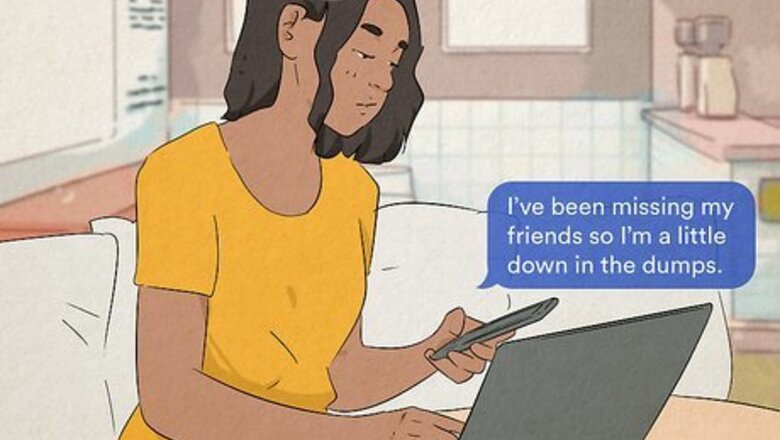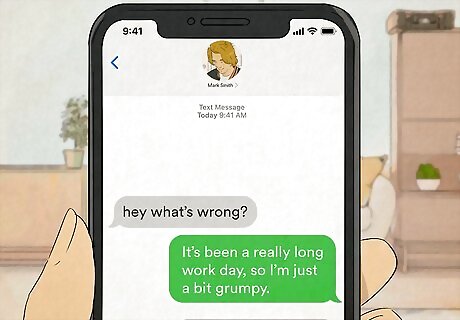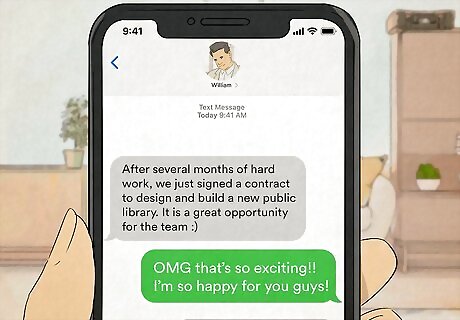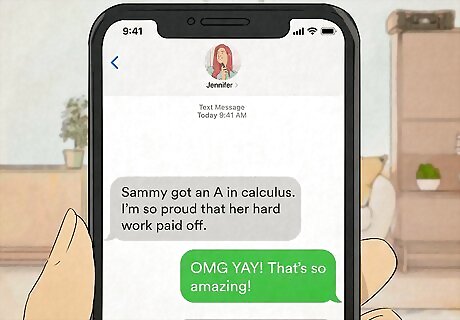
views
- Describe your emotions outright rather than talking around them. Say, "I'm so excited for tonight!" or, "I'm feeling a little bummed out."
- Use exclamation marks to express excitement, or periods to let the person know your message is more serious.
- Use emojis that correspond to how you want the message to be read. Use smiling faces for positive emotions, and frowning faces for negative emotions.
Name your feelings.

Be honest with your emotions so the person isn’t confused. Rather than trying to hide how you’re feeling from the other person, don’t be afraid to come right out and say it. Take a second to reflect on your emotions so you can accurately tell the person you’re chatting with. For example, to show that you’re happy, you could say something like, “Ah! I am so excited for you!” or, “That makes me feel amazing!” If you’re talking about more serious topics, you might try something like, “I’m just a bit upset,” or, “I’ve been feeling a little depressed recently.” Try looking at a feelings chart online to find a good range of words to use. For example, instead of saying “good,” you might try “joyful,” “fortunate,” or “appreciative.”
State what’s making you feel a certain way.

The person may understand better if they know what caused your mood. If you just give a one-word answer on how you’re feeling, it doesn’t give a lot for the other person to continue the conversation. It might take a little bit to figure out what’s making you feel that way, but try your best to find the cause. For example, if you’re looking forward to a date, you might say something like, “I’m so excited to grab dinner with you tonight!” If you’re upset about a bad day at work, try saying, “It’s been a really long work day, so I’m just a bit grumpy.”
Write longer descriptions of your emotions.

Sending short messages tends to sound passive-aggressive. Saying something like “I’m good,” or “I’m fine,” leaves a lot of mystery about how you’re actually feeling. Go into a little more detail about how you’re feeling so the person you’re messaging doesn’t assume the wrong idea. Pepper in some descriptive words that help capture your emotion a little better. Rather than saying “I’m good,” you may say, “It’s been a fantastic day so I’m doing great!” Instead of saying, “I’m sad,” you could try, “I’ve had a rough time lately, so I’m feeling a bit down.”
Use punctuation.

Different punctuation marks affect how someone reads your tone. It’s okay to use periods on longer sentences, but leave it off of shorter one-word texts since it could make your message sound negative. If you want to show you’re excited or really passionate about something, try an exclamation point instead. Everyone has a different texting style, so read through your other texts to get an idea of how the person uses punctuation. You could try saying something like, “OMG that’s so exciting!! I’m so happy for you!” For example, saying “Okay.” sounds a lot harsher than saying “Okay” without the period, though the latter might sound more dismissive. Just be careful not to end every sentence with exclamation points so you don’t overuse them.
Add in emojis.

Someone can instantly see how you feel based on the emoji you use. If your text could be taken a few different ways, try to add a small emoticon or emoji somewhere in the message. There are tons of emojis to choose from, so just find one that matches your mood to use. Just be careful not to overuse or rely only on emojis to talk about how you’re feeling. If you’re happy, try ????, ????, or ????. If you want to convey a silly mood, use ????, ????, or ????. When you’re sad, try ????, ☹️, or ????. If you’re angry, you might use ????, ????, or ????.
Capitalize words to show they’re important.

Typing LIKE THIS works for conveying excitement and anger. Pick 1 or 2 words to emphasize since capitalizing every word could make it seem like you’re yelling. The word you choose really depends on what you’re texting, but try to pick one that matches the mood that you’re trying to capture. For example, if you’re angry, you might try saying, “WHY would you do THAT! ????” If you want to show that you’re excited, you can say, “OMG YAY! That’s so amazing!”
Emphasize words with extra letters.

Repeat the same letter in a word so it draws more attention. The other person may try to assume your emotions from which words you chose to lengthen, so clearly say how you’re feeling somewhere in the message. Just be careful not to overuse this technique in your messages since it could make them harder to read. For example, if you’re feeling anxious while you’re waiting for something, you might say, “I am soooo boooored,” or “This is taking foreverrrrr.” If you’re excited, you could try saying something like, “Yessss!! That’s such good news!” If you’re curious about something, you might say, “I dunno about that. Are you suuuuure?”
Type “haha” or “lol” if you’re laughing.

A quick chuckle keeps your conversation light-hearted. Laughing lets the person you’re talking to know that you’re not looking for a serious convo. Rather than only sending “haha” or “lol” as a one-word message, tack it onto another longer message that talks about your emotions in a little more detail. For example, you could say something like, “It’s been a long day, but I’m doing pretty good hahah!” or “LOL you always know what to say ????”
End your message with a tone indicator.

A tone indicator is a forward slash followed by letters at the end of a message. Adding an indicator quickly lets someone know the intent of your text. Since the other person can’t hear your voice, the tone indicator lets them know how they’re supposed to read the message in their head. Some tone indicators you can try include: /j for joking: “I’m so mad you took the last cookie /j” /s for sarcasm: “Wow, work was the most fun I’ve ever had /s” /srs for serious: “I could just break down in tears rn /srs”
Reread your text before sending it.

Make sure the emotion of your words matches your real feelings. Quickly scan through your text and see if what you’re trying to say reads clearly. Compare the tone of the message to what you’re really trying to say to make sure they match. If you need to, go in and clarify your text before pressing send. For example, saying “We need to talk,” could make the other person feel really anxious if you really meant, “Ugh something came up this weekend so we need to talk about rescheduling our plans.”
Have serious conversations on the phone or face-to-face.

You can express yourself and read emotions better in person. Even after trying all of these tricks, some people still might get confused by how you really feel. Rather than trying to have the conversation over text, ask if they can meet up to chat. Since they’ll be able to hear your voice and see your expressions, they’ll understand how you’re feeling. If you can’t get together with the person, call them on the phone or hop on a video call so it’s easier to talk.

















Comments
0 comment